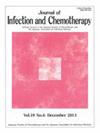登革病毒血清4型感染不是通过快速抗原试验诊断,而是通过实时逆转录- pcr和酶联免疫吸附试验诊断:1例报告
IF 1.5
4区 医学
Q3 INFECTIOUS DISEASES
引用次数: 0
摘要
一名39岁日本男性在马来西亚旅行5天后以发热、头痛和关节疼痛来我院就诊。血液检查显示白细胞和血小板计数减少。虽然怀疑为登革热,但症状出现后第5天的快速诊断试验(RDT)对登革病毒(DENV)非结构蛋白1 (NS1)抗原、DENV IgM抗体和DENV IgG抗体均呈阴性。由于不能根据临床症状排除登革热,因此进行了额外的实时逆转录- pcr (RT-PCR)检测和酶联免疫吸附测定(ELISA)。采用实时RT-PCR检测血清中DENV血清4型(DENV-4)基因组。ELISA法检测DENV NS1抗原、IgM抗体、IgG抗体。这是一个登革热病例,不是基于RDT诊断,而是基于实时RT-PCR和ELISA诊断。当RDT结果为阴性,但怀疑是登革热时,必须进行实时RT-PCR或ELISA检测,以正确诊断DENV感染患者。本文章由计算机程序翻译,如有差异,请以英文原文为准。
Dengue virus serotype 4 infection diagnosed not by rapid antigen test, but by real-time reverse transcription-PCR and enzyme-linked immunosorbent assay: A case report
A 39-year-old Japanese male visited our hospital with fever, headache, and joint pain after a 5-day trip to Malaysia. Blood tests revealed decreased white blood cell and platelet counts. Although dengue was suspected, a rapid diagnostic test (RDT) on the 5th day after symptom onset was negative for dengue virus (DENV) nonstructural protein 1 (NS1) antigen, DENV IgM antibody, and DENV IgG antibody. Since dengue could not be ruled out in light of the clinical symptoms, an additional real-time reverse transcription-PCR (RT-PCR) test and enzyme-linked immunosorbent assay (ELISA) were performed. The DENV serotype 4 (DENV-4) genome was detected in the serum using real-time RT-PCR. DENV NS1 antigen, IgM antibody, and IgG antibody were detected in the serum using ELISA. This is a case of dengue diagnosed based not on RDT but on real-time RT-PCR and ELISA. When RDT results are negative, but dengue is suspected, additional real-time RT-PCR or ELISA testing must be performed to correctly diagnose patients with DENV infection.
求助全文
通过发布文献求助,成功后即可免费获取论文全文。
去求助
来源期刊

Journal of Infection and Chemotherapy
INFECTIOUS DISEASES-PHARMACOLOGY & PHARMACY
CiteScore
4.10
自引率
4.50%
发文量
303
审稿时长
47 days
期刊介绍:
The Journal of Infection and Chemotherapy (JIC) — official journal of the Japanese Society of Chemotherapy and The Japanese Association for Infectious Diseases — welcomes original papers, laboratory or clinical, as well as case reports, notes, committee reports, surveillance and guidelines from all parts of the world on all aspects of chemotherapy, covering the pathogenesis, diagnosis, treatment, and control of infection, including treatment with anticancer drugs. Experimental studies on animal models and pharmacokinetics, and reports on epidemiology and clinical trials are particularly welcome.
 求助内容:
求助内容: 应助结果提醒方式:
应助结果提醒方式:


